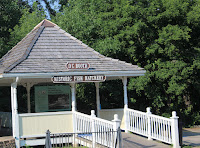 |
| Young trout in Booth Hatchery raceway |
 |
| Booth Hatchery trout ponds |
 |
| Underwater viewpoint, Booth Hatchery trout ponds |
Spearfish isn’t an easy name to forget, and the town does its best to stay unforgettable. The last city in South Dakota before the Black Hills extend into Wyoming, Spearfish lies below a series of low mountains on either flank.
The interstate gives little inkling of the town as it winds through the western Black Hills past Sturgis, its annual motorcycle rally just weeks away. Spearfish essentially becomes part of Sturgis when the Harleys roar, but in mid-July, it feels much more chill than Rapid City.
The downtown core has a mix of century-old buildings and modern structures, with boutiques, restaurants, coffeehouses, and breweries boosting the summertime pedestrian traffic. But the real attractions lie down Canyon Street.
The innocuous street passes a series of light industrial businesses and city buildings before reaching some historic canals and the site of a mill founded around the same time as the city. The comes the fish hatchery that made Spearfish famous.
 |
| Many trout |
One of the first government-run fish hatcheries in the west, the D.C. Booth Fish Hatchery helped restock trout in lakes and ponds round the American West in the early 20th century. Pioneers had depleted stocks in many lakes, simply deploying giant nets to capture as many fish as possible. The empty ponds required government intervention at that point, and the U.S. Fish and Wildlife Service used the hatcheries to forward this aim.
Named for Dewitt Clinton Booth, the first superintendent of hatchery, it has faced numerous attempts to close it over the years but has endured as the archive of the nation’s fish hatcheries and a major attraction for the city.The hatchery still spawns 20,000 to 30,000 rainbow trout every year, and several types of trout – rainbow, brook, brown, and XXXX – occupy the historic ponds. Rainbow trout fill the concrete channels.
The hatchery abuts the Spearfish City campground where I stayed for the night. My good friend Jess received an artist-in-residence assignment at the Booth, and that seemed like a good time to visit. I reserved a campsite, but I could not refuse an air mattress in my friend’s air-conditioned trailer after the recent heatwave.
From the Volunteer Village portion of the campground, the ponds and visitor center of the hatchery sat just across the road. On a hill above the hatchery ponds sits the Booth House, where the superintendent and his family lived. Restored with period furnishings, it has some interesting features, such as a second-floor sewing room. Vast gardens surround the house.
My friend gave me an informal version of the tour. The hatchery also offered a history of hatcheries through vehicles once used to stock fish. First came The Yellowstone, a restored boat once used to harvest trout eggs from Lake Yellowstone in the national park.
The hatchery also boasts a restored train car to approximate the cars the Fish and Wildlife Service used to transport fish before automobiles. The special car had numerous steel tanks to keep the fish chilled during transport. Restoration continues, as several chandeliers are still works in progress. But the fish transport car retained a spartan elegance, with its own bathroom, kitchen, and sleeping berths.
 |
| Restored train car |
 |
| Fish restocking train car interior |
On the hills around the hatchery, I could hear the poison ivy taunting me, wondering why it hadn’t seen such an easy mark in so many years. So I stayed off the hatchery trails, even if they promised scenic overlooks.
 |
| A Spearfish original |
The activity along Canyon Street didn’t end when the hatchery closed. Wednesday summer nights brough concerts to Spearfish’s city park.
The breezy bluegrass band drew several hundred people to the city park, with a line of food trucks and drink vendors.
The air cooled off quickly, with the band wrapping up around dark. When they ended, the swift rush of Spearfish Creek again became the town soundtrack.
The heat wore off quickly. The campground quieted. No one stirred but a few ducks protecting their young on the hatchery pond island. In the cool morning, I joined my friend in walking her dog around the campground.
We repeated the walk in the morning, then we adjourned to The Original Spearfish Breakfast House, because nothing else had a name that demanded we visit. The small spot only has about 15 tables but serves up dynamite breakfast. Our waiter was a retired gentlemen who lived in Spearfish for 35 years and sang the town’s praises.I bid my friend Jess goodbye and took a long look at the historic buildings and rushing Spearfish Creek. On a future trip, I'll drive Spearfish Canyon back to Wyoming; it's one of the few scenic paved drives I still need to cover in the Black Hills.
I had reached the Black Hills just before the crush of motorcycle enthusiasts return for Sturgis. Campsites and hotel rooms become impossible to find, many restaurants slim their menus and raise their rates.
In three turns I resumed the frantic pace of the interstate. But the delights of friendly Spearfish would stick with me far longer.
 |
| Bridge to the hatchery |
 |
| Spearfish Creek |


No comments:
Post a Comment